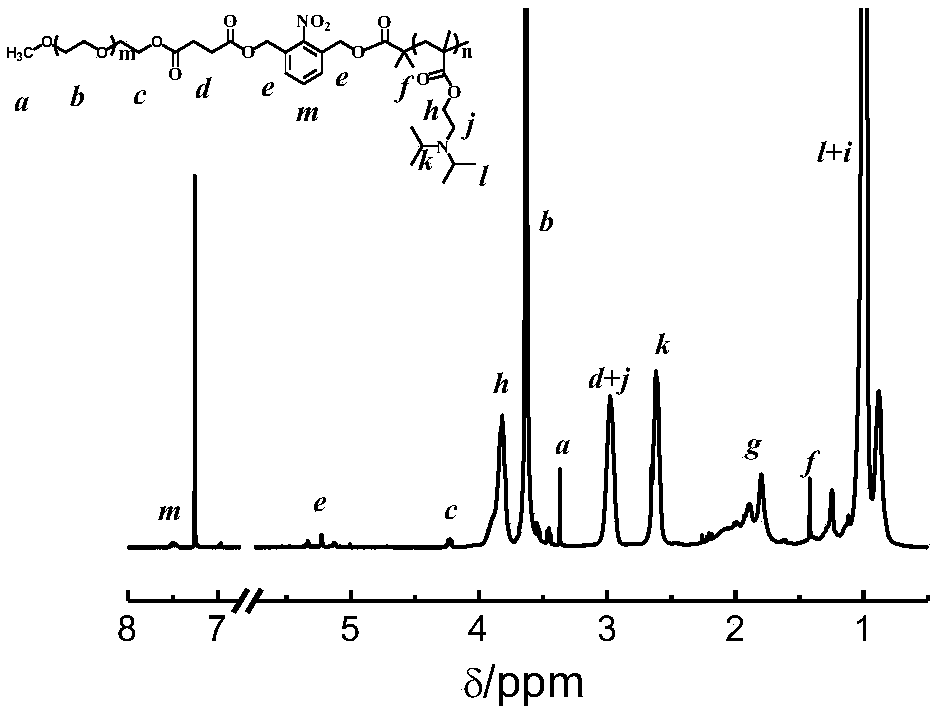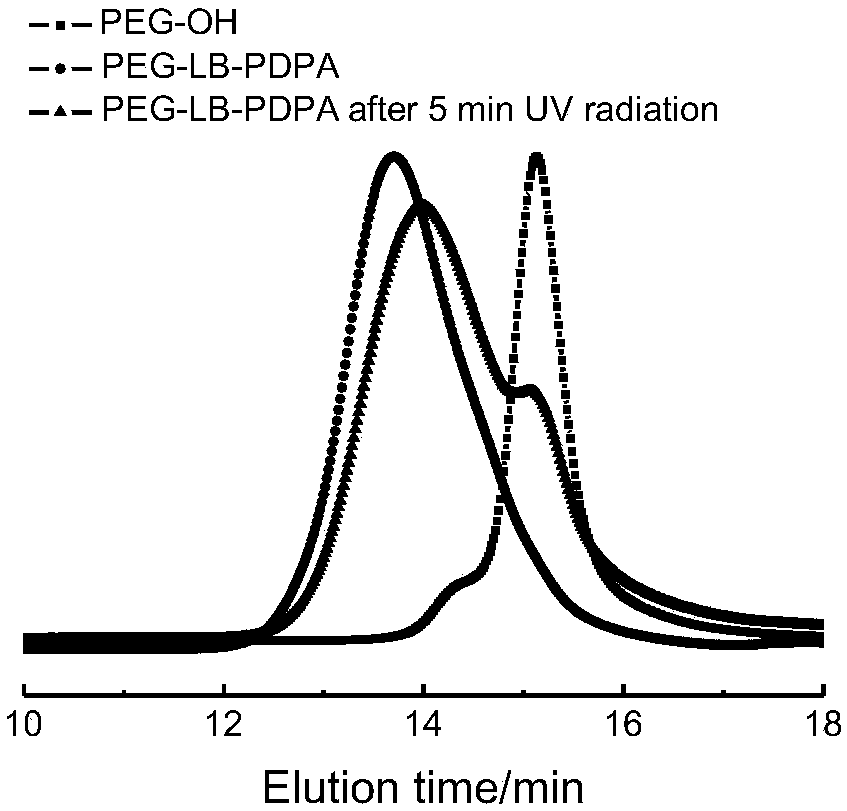Two-block copolymer with light and pH (potential of hydrogen) double responsiveness and preparation method thereof
A block copolymer, responsive technology, applied in the direction of non-active ingredient medical preparations, pharmaceutical formulations, emulsion delivery, etc., can solve the problems of low cell uptake of carriers, protein adhesion, etc.
- Summary
- Abstract
- Description
- Claims
- Application Information
AI Technical Summary
Problems solved by technology
Method used
Image
Examples
Embodiment example 1
[0022] Example 1: Preparation of light and pH dual-responsive diblock copolymer PEG-LB-PDPA
[0023] Preparation of carboxyl-terminated polyethylene glycol: Weigh 10 g of polyethylene glycol monomethyl ether and dissolve it in 50 mL of dichloromethane, add 0.4 g of succinic anhydride and 0.25 mL of triethylamine in sequence, react at room temperature for 24 hours, and remove by rotary evaporation Excess solvent was precipitated three times in diethyl ether, and vacuum-dried to constant weight to obtain carboxyl-terminated polyethylene glycol;
[0024] Preparation of o-nitrobenzyl ester-terminated polyethylene glycol: Dissolve 3 g of carboxy-terminated polyethylene glycol in 15 mL of dichloromethane, add 0.2 g of 2-nitro-1,3-benzyl glycol, 0.48g N,N-dicyclohexylimine, and 0.15g 4-dimethylaminopyridine, reacted at room temperature for 24h, rotary evaporated to remove excess solvent, precipitated in ether three times, dried in vacuum to constant weight, and obtained o-nitro Benz...
Embodiment example 2
[0028] Example 2: Preparation of light and pH dual-responsive diblock copolymer PEG-LB-P (DMA-co-DPA)
[0029] Take by weighing the ATRP macroinitiator prepared in 0.5g embodiment case 1, 1.02g 2-(diisopropylamino) ethyl methacrylate, 0.54g 2-(dimethylamino) ethyl methacrylate, 21 μ L N,N,N',N,'N"-pentamethyldiethylenetriamine and 14mg cuprous bromide, then add 1mL isopropanol and 1mL N,N-dimethylformamide to dissolve the monomer and initiate reagent, and reacted overnight at 50°C in the absence of oxygen. After the reaction was completed, 10 mL of THF was added to quench the reaction, and the copper salt was removed through a neutral alumina column, dialyzed in deionized water for 3 days, and freeze-dried to obtain light and pH dual responsiveness. Block copolymer PEG-LB-P (DMA-co-DPA).
Embodiment example 3
[0030] Example 3: Preparation of light and pH dual-responsive diblock copolymer PEG-LB-P (DEA-co-DPA)
[0031] Take by weighing the ATRP macroinitiator prepared in 0.5g embodiment case 1, 1.02g 2-(diisopropylamino) ethyl methacrylate, 0.67g 2-(diethylamino) ethyl methacrylate, 21 μ L N,N,N',N,'N"-pentamethyldiethylenetriamine and 14mg cuprous bromide, then add 1mL isopropanol and 1mL N,N-dimethylformamide to dissolve the monomer and initiate reagent, and reacted overnight at 50°C in the absence of oxygen. After the reaction was completed, 10mL THF was added to quench the reaction, and the copper salt was removed through a neutral alumina column, dialyzed in deionized water for 3 days, and freeze-dried to obtain light and pH dual responsiveness. Block copolymer PEG-LB-P (DEA-co-DPA).
PUM
| Property | Measurement | Unit |
|---|---|---|
| particle diameter | aaaaa | aaaaa |
| particle size | aaaaa | aaaaa |
Abstract
Description
Claims
Application Information
 Login to View More
Login to View More - R&D
- Intellectual Property
- Life Sciences
- Materials
- Tech Scout
- Unparalleled Data Quality
- Higher Quality Content
- 60% Fewer Hallucinations
Browse by: Latest US Patents, China's latest patents, Technical Efficacy Thesaurus, Application Domain, Technology Topic, Popular Technical Reports.
© 2025 PatSnap. All rights reserved.Legal|Privacy policy|Modern Slavery Act Transparency Statement|Sitemap|About US| Contact US: help@patsnap.com



